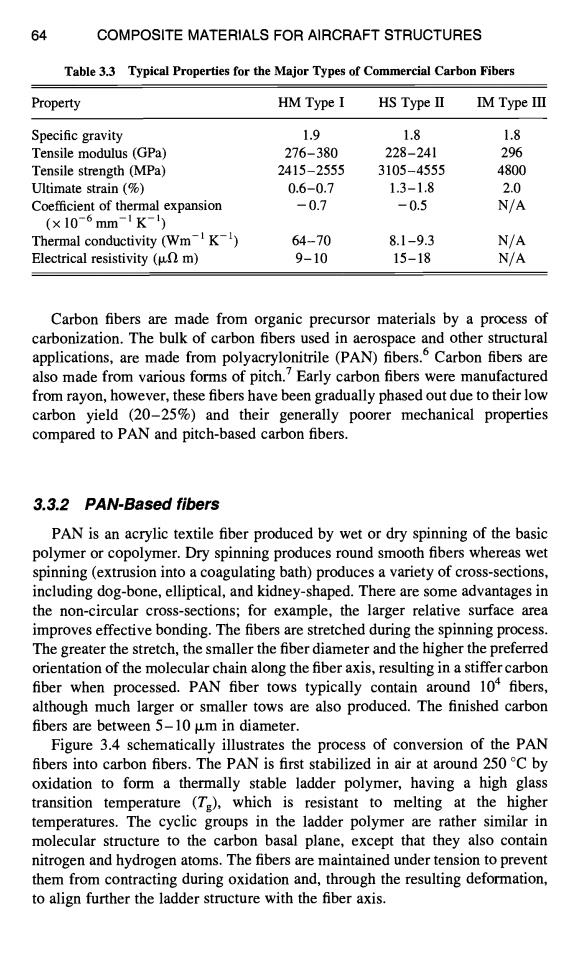正在加载图片...

64 COMPOSITE MATERIALS FOR AIRCRAFT STRUCTURES Table 3.3 Typical Properties for the Major Types of Commercial Carbon Fibers Property HM Type I HS TypeⅡ M TypeⅢ Specific gravity 1.9 1.8 1.8 Tensile modulus (GPa) 276-380 228-241 296 Tensile strength (MPa) 2415-2555 3105-4555 4800 Ultimate strain (% 0.6-0.7 1.3-1.8 2.0 Coefficient of thermal expansion -0.7 -0.5 N/A (×10-6mm-1K) Thermal conductivity (Wm-K-) 64-70 8.1-9.3 N/A Electrical resistivity (un m) 9-10 15-18 N/A Carbon fibers are made from organic precursor materials by a process of carbonization.The bulk of carbon fibers used in aerospace and other structural applications,are made from polyacrylonitrile (PAN)fibers.Carbon fibers are also made from various forms of pitch.'Early carbon fibers were manufactured from rayon,however,these fibers have been gradually phased out due to their low carbon yield (20-25%)and their generally poorer mechanical properties compared to PAN and pitch-based carbon fibers. 3.3.2 PAN-Based fibers PAN is an acrylic textile fiber produced by wet or dry spinning of the basic polymer or copolymer.Dry spinning produces round smooth fibers whereas wet spinning (extrusion into a coagulating bath)produces a variety of cross-sections, including dog-bone,elliptical,and kidney-shaped.There are some advantages in the non-circular cross-sections;for example,the larger relative surface area improves effective bonding.The fibers are stretched during the spinning process. The greater the stretch,the smaller the fiber diameter and the higher the preferred orientation of the molecular chain along the fiber axis,resulting in a stiffer carbon fiber when processed.PAN fiber tows typically contain around 104 fibers, although much larger or smaller tows are also produced.The finished carbon fibers are between 5-10 um in diameter. Figure 3.4 schematically illustrates the process of conversion of the PAN fibers into carbon fibers.The PAN is first stabilized in air at around 250C by oxidation to form a thermally stable ladder polymer,having a high glass transition temperature (Ts),which is resistant to melting at the higher temperatures.The cyclic groups in the ladder polymer are rather similar in molecular structure to the carbon basal plane,except that they also contain nitrogen and hydrogen atoms.The fibers are maintained under tension to prevent them from contracting during oxidation and,through the resulting deformation, to align further the ladder structure with the fiber axis.64 COMPOSITE MATERIALS FOR AIRCRAFT STRUCTURES Table 3.3 Typical Properties for the Major Types of Commercial Carbon Fibers Property HM Type I HS Type II IM Type III Specific gravity 1.9 1.8 1.8 Tensile modulus (GPa) 276-380 228-241 296 Tensile strength (MPa) 2415-2555 3105-4555 4800 Ultimate strain (%) 0.6-0.7 1.3-1.8 2.0 Coefficient of thermal expansion - 0.7 - 0.5 N/A (× 10 -6 mrn -1 K -1) Thermal conductivity (Wm- 1 K- 1) 64-70 8.1-9.3 N/A Electrical resistivity (V~ m) 9-10 15-18 N/A Carbon fibers are made from organic precursor materials by a process of carbonization. The bulk of carbon fibers used in aerospace and other structural applications, are made from polyacrylonitrile (PAN) fibers. 6 Carbon fibers are also made from various forms of pitch. 7 Early carbon fibers were manufactured from rayon, however, these fibers have been gradually phased out due to their low carbon yield (20-25%) and their generally poorer mechanical properties compared to PAN and pitch-based carbon fibers. 3.3.2 PAN-Based fibers PAN is an acrylic textile fiber produced by wet or dry spinning of the basic polymer or copolymer. Dry spinning produces round smooth fibers whereas wet spinning (extrusion into a coagulating bath) produces a variety of cross-sections, including dog-bone, elliptical, and kidney-shaped. There are some advantages in the non-circular cross-sections; for example, the larger relative surface area improves effective bonding. The fibers are stretched during the spinning process. The greater the stretch, the smaller the fiber diameter and the higher the preferred orientation of the molecular chain along the fiber axis, resulting in a stiffer carbon fiber when processed. PAN fiber tows typically contain around 10 4 fibers, although much larger or smaller tows are also produced. The finished carbon fibers are between 5-10 txm in diameter. Figure 3.4 schematically illustrates the process of conversion of the PAN fibers into carbon fibers. The PAN is first stabilized in air at around 250 °C by oxidation to form a thermally stable ladder polymer, having a high glass transition temperature (Tg), which is resistant to melting at the higher temperatures. The cyclic groups in the ladder polymer are rather similar in molecular structure to the carbon basal plane, except that they also contain nitrogen and hydrogen atoms. The fibers are maintained under tension to prevent them from contracting during oxidation and, through the resulting deformation, to align further the ladder structure with the fiber axis